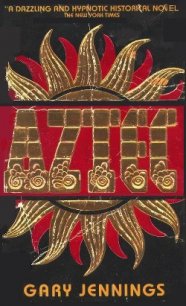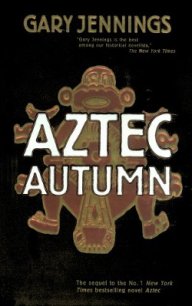Aztec Blood - Jennings Gary (книги онлайн бесплатно серия .txt) 📗
I read and reread not only the great works that had been contained in the fray's library, almost all of which the don had also, but practical books like Father Agustin Farfan's treatise on medicine, the works of the great pharmaceuticist Mesue, the ninth-century Arabic doctor at the court of Harun-Al-Raschid at Bagdad, the secrets of surgery revealed by the Spaniard Benavides, Sahagun's history of the indios, and Bernal Diaz del Castillo's history of the conquest.
The don's library was stuffed with the works of Galen, Aristotelian science, and Arabic doctors; writing of the Greek philosophers, Roman lawgivers, and the Renaissance poets and artists; tomes on engineering and the cosmos. Of the most fascinating works were those of the technique of surgery to put a nose on a person after it was cut off, the story of the sinful French disease, also called syphilis, and Ambroise Pare's battlefield surgery techniques.
A surgeon in Italy had developed a procedure to replace the noses of those who had had them cut off. Don Julio said that the surgeon was motivated by the plight of a young woman from Genoa whose nose had been cut off by some soldiers who were enraged at the resistance she offered to the rape they were conducting.
Gaspare Tagliacozzi, the Italian surgeon, died about the time I was being born. He had studied a Hindu method of surgery in which a flap of the skin of the forehead was draped down and shaped to form a nose. The upper part of the flap, still attached to the forehead, was left attached until the nose part grew on the flesh. The Hindus had developed this art from necessity—many Hindu woman lost their noses for real or imagined infidelities.
The Hindu method left a large, pyramid-shaped scar on the patient's forehead. Tagliacozzi developed a method of using the same amount of skin but obtaining it from under the forearm. Because the forearm was mobile, a frame was built around the person's head to hold the forearm against the nose area until the forearm flap of skin attached itself to form a new nose.
He also performed similar operations for repair on the ears, lips, and tongue.
As for the young woman from Genoa whose defense of her virtues caused the loss of her nose, it is said that the operation was a complete success, except that in cold weather her nose developed a rather purplish hue.
Tagliacozzi relates his techniques in De Chirurgia Curtorum Per Insitionem, published a couple of years before his death, a copy of which in Spanish found its way to the don's library.
One of the worst contagions on the face of the earth is commonly called syphilis, or the French disease. It is said that the disease got its name from the shepherd Syphlius, who insulted Apollo; the angry god inflicted upon Syphlius a loathsome disease that spread like wildfire.
Syphilis has struck the hearts of every man and woman in the New World and the old. Acquired through copulation, many men have carried it home to their wives. The priests chide us that syphilis is a disease of sin, put on earth by God to punish the promiscuous, but what sin does an innocent woman commit who gets this dreaded affliction because the husband she has no control over carries it home from a whore or an amorous adventure?
For those who do not shake it in its early stages, there is no cure for the disease except death. For some the death comes slowly, eating away the life of the person; others are carried away mercifully—but painfully—quickly. One out of every two persons who get the contagion dies from it.
The treatment is as horrible as the frightful, raw, painful rash and ulcers that cover an infected person's body. When the sores are present on the body, the infected person is placed in a barrel or tub with mercury in it. A tub ordinarily used for the salting of meat so that it would last longer was often utilized. Tub or barrel, the container was large enough to contain the body of a man and so it was used for sweating out the malady and fumigating syphilitics. The contents of the container, man and mercury in powder or liquid form, were heated.
It is said the cure kills as many as the disease. Many of those who survive the cure have tremors of the hands, feet, and head along with frightening grimaces, death's head skull grins.
Don Julio told me that alchemists, who supplied the mercury compound to barbers and others who gave the treatments, finally realized their dreams of turning mercury into gold by the treatment of syphilis.
Some claim Columbus's men brought the dreaded disease back from America. On their return to Spain, many of them chose to become mercenaries and had hurried to join King Ferdinand of Naples, who was defending his kingdom against King Charles of France. After Naples fell, the Spaniards entered the service of the French king and carried the disease along with them to France. Because of its early prevalence in the French army, it earned the common name of the "French disease."
The indios deny that the disease is a New World one and claim that the Spaniards brought it with them and that it killed as many indios as the peste and vomito.
Who knows? Perhaps both are right—the Lord acts in mysterious ways.
Another wonderful story of medicine fascinated me, that of the French battlefield surgeon, Ambriose Pare. This was another man who died not too long before my birth.
When Pare was a young army surgeon, the common way to stop bleeding of a gunshot wound was to cauterize it with boiling oil. The black powder used in cannons and smaller weapons was considered poisonous; boiling oil was applied to eliminate the poison, stop the bleeding, and cure the wound. Applying hot oil to a wound was extremely painful to the soldiers who were already suffering great pain.
During a period of heavy casualties, Pare ran out of oil and improvised, applying a salve made from egg yolks, rose essence, and turpentine. To stop the bleeding, he took the radical step of sewing closed the damaged arteries. To his surprise, and the surprise of the surgeons working around him, his patients almost all survived, while the death rate on those who had boiling oil applied was exceptionally high.
Like many heroes of medicine and science, Pare was not immediately proclaimed a hero. Careful to give the Inquisition its due, he always denied he had cured the men. To avoid a charge that he was in league with the devil, after every treatment, he said, "I dressed his wound; God healed him."
It is from Pare that Don Julio learned the technique of removing a musket ball or arrow with the person in the same position as when the object entered.
Alas, the price of fame and success: Pare's fame grew, jealous surgeons tried to poison him.
After reading of Pare's skills and knowledge and seeing Don Julio's educated application of medicine, I was struck by how miraculous it was that Fray Antonio was able to perform surgery with little knowledge of anatomy and kitchen utensils for instruments. Eh, no doubt the Lord was guiding his hands.
Thinking about the miracles the fray performed, the tale of another medical miracle came to mind. Suffering from a gangrenous left leg, a farmer named Roberto fell into a coma at the door of a church. In his unconscious state, he dreamt that saints had come and removed him to a hospital. The saints performed an operation to amputate the leg below the knee and performed the same operation, postmortem, on a patient who had died in an adjoining bed. They sewed the leg from the dead man onto the farmer. When Roberto awoke the next day, he discovered he had two sound legs.
When he returned home from the hospital, Roberto told his family and friends about the incident. Each time he told them that he had been the recipient of a miracle, that saints themselves had sewed the leg of a dead man to replace his amputated one, people scoffed. When they did, he lifted up his pants to prove his story.




